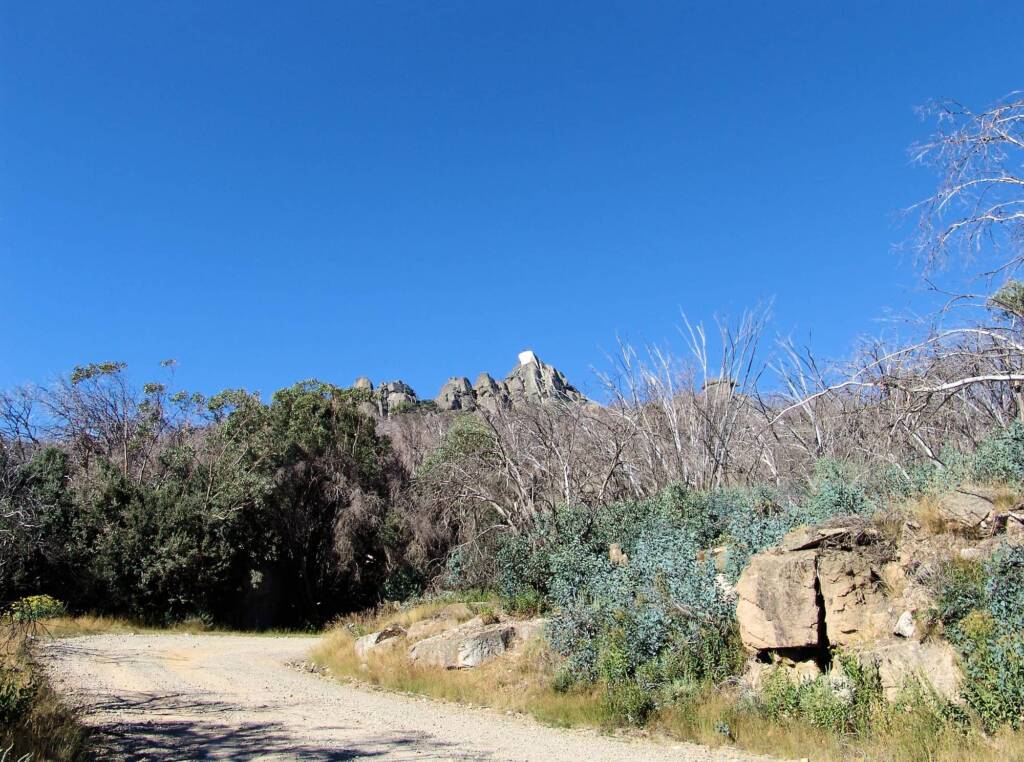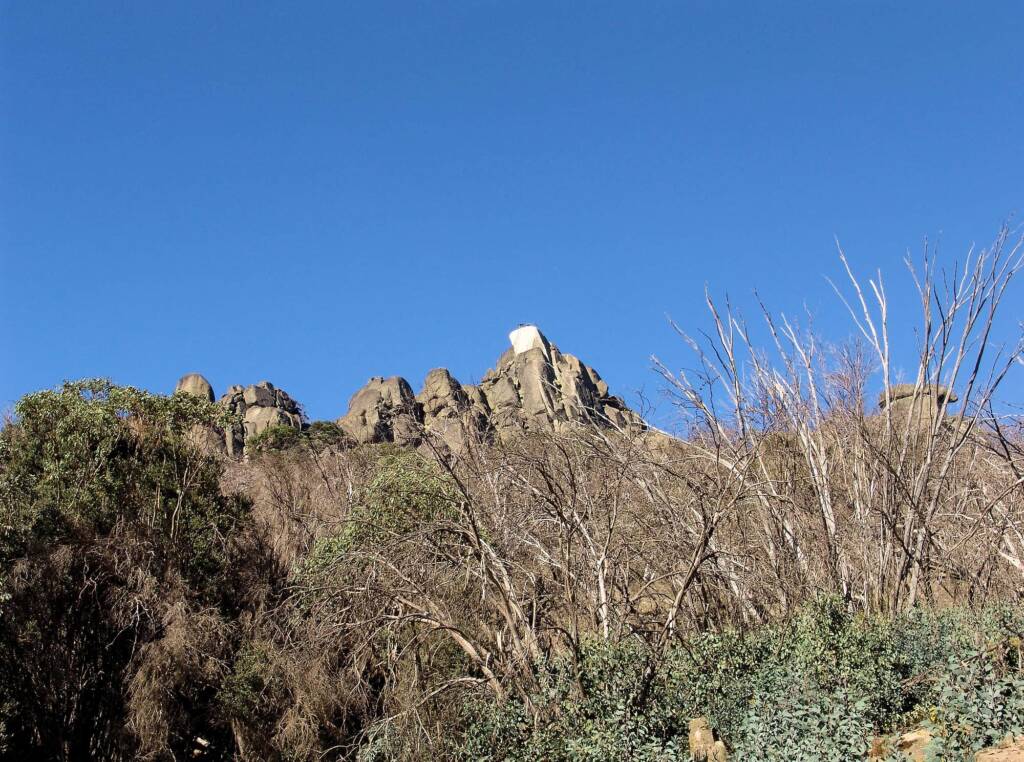Mount BuffaloEurobin Falls The Gorge Precinct Mt Buffalo National Park Story Torpedo Rock
A long, long time ago, during a period when the area was covered with sedimentary rock laid down the by sea, over a period of more than 360 million years, natural forces set about exposing and eroding a huge granite ‘batholith’ which had been forced up into the earth’s crust as a molten mass. These fantastically shaped boulders and tors were further shaped and eroded by heat, wind, plants, water and ice, that attacked the joints in the granite, widening the cracks, and forming soil from which plants took root and grew.
Today, Mount Buffalo is a 3rd of its former height, providing an isolated plateau environment with harsh alpine climate and a range of altitudes that have resulted in a diverse array of plants and animals. This natural wonderland includes the Buffalo Sallee, Buffalo Sallow Wattle and Fern-leaf Baeckea, plants that are found nowhere else in the world. The rich plant communities range from the dry, foothill forests, tall wet mountain forest, Snow Gum woodlands, alpine heathlands, sphagnum bogs, Snow-grass plains and wildflowers.

Annual Arrival
With the annual arrival of the Bogong Moths each summer, the Minjambuta Aboriginal People journeyed up the mountain gathered together for ceremonies, socialising and feasting.
When explorers Hume and Hovell passed present day Glenrowan in 1824 on their journey to Port Phillip, they named Mount Buffalo, likening it to a sleeping buffalo.
In the 1830’s, squatters were the first to take up land in the area. The 1850’s saw gold miners rushing to the surrounding valleys seeking their fortunes. With the dwindling of the gold, many miners left, but some remained to settle the area. Seeking summer grazing land they became curious with what lay hidden on the top of the rugged ‘buffalo mountains’ and began guiding wealthy tourists up to the ‘island in the sky’.

Minjambuta, Moths and Migration
The Minjambuta are believed to be the Aboriginal people who regularly visited the Mount Buffalo Plateau. In the winter, the Minjambuta lived in the warmer valleys, below the snowline. Then, in the early summer they would being their annual journey up into the high country, to feast on the abundant Bogong Moth. It was a time for feasting, ceremony and socialising.
The Bogong Moth (Agrotis infusa) begins life as caterpillars (also known as cutworms), feeding on the winter plains west of the Great Dividing Range (inland NSW and Queensland). The summer high temperatures make the plains unfavourable for the Bogongs, so the adult moths emerge in spring to begin their migration to the cooler high country of the Great Dividing Range (usually above 1,700 metres) where they congregate in caves around the area of Mount Bogong in the Bogong National Park. Over the summer period (November to February), the adults remain congregated in the rock crevices in massive numbers, remaining dormant, whilst living off their fat reserves. The approach of winter, sees them migrate north to mate, lay their eggs, and then die, ending their annual cycle. The eggs then pupate in a cocoon in their burrow beneath the soil, with the adults emerging about four weeks later.
The Horn (1,723 m) is the highest point of Mount Buffalo and during these migration periods, the Bogong Moth can be seen in their millions. As you climb to the summit, contemplate both the Minjambuta’s journeys and the Bogong Moth’s migration to this unique place.
A Park is Born
The Bright Alpine Club actively lobbied the government to protect the area. Subsequently 1,152 ha surrounding the Gorge was declared a national park in 1898, becoming (with Wilsons Promontory) one of our first national parks.
The park then became a focus for tourism and in 1908, a road was cut up the mountain. Two years later Mount Buffalo Chalet was built, becoming very popular with the visitors to the region. In 1836, Australia’s first ski tow was installed at Cresta Valley.
In 1998 Mount Buffalo celebrated its centenary. It now covered 31,000 ha, encompassing the entire plateau and most of the forested foothills down to nearby valleys.
The park is also now part of the collective Australian Alps National Parks. A co-operative agreement between NSW, ACT, Victoria and the Commonwealth assists with cohesive management of fragile alpine eco-systems.

Fire in the Alps
During the summer of 2003, a number of fires swept through the Australian Alps from Mount Buffalo to Namadgi. Over time, nature will take its course and the natural environment will recover, although some alpine (ie bog and wetland) and subalpine (snow gum and alpine ash) communities will take longer to regenerate.
Please keep to tracks and trails, especially in the fire affected areas. Regeneration of sensitive burnt areas will be assisted without the additional impact of tramping.
Burnt visitor facilities and directional signs will be replaced with exception of some historic huts, which may remain as ruins. If planning a visit to a hut, check it has not been destroyed by fire.
Source: Parks Victoria




More information coming…
Victorian Alpine Region > Beechworth | Benalla | Chiltern | Corryong | Eildon | Falls Creek | Glenrowan | Harrietville | King Valley & Milawa | Kinglake | Lake Mountain | Mansfield | Mount Beauty | Mount Buffalo | Mount Buller | Mount Stirling | Mountain Creek | Rutherglen | Tallangatta | Yackandandah | Yea
Great Alpine Road > Alpine National Park | Bairnsdale | Bright | Dinner Plain | Harrietville | Lakes Entrance | Mount Hotham | Myrtleford | Omeo | Oxley | Porepunkah | Wangaratta ◦ Other regions: Victoria’s High Country | NSW Snowy Mountain Region
Other towns, villages and localities in the Great Alpine Road include: Bruthen • Ensay • Eurobin Falls • Everton • Ovens • Swifts Creek • Tarrawingee
Footnote & References
- The Gorge Precinct, Visit Mount Buffalo, https://visitmountbuffalo.com.au/sightseeing/the-gorge/
- Victoria’s High Country, https://www.victoriashighcountry.com.au/
Mount BuffaloEurobin Falls The Gorge Precinct Mt Buffalo National Park Story Torpedo Rock
VictoriaAlpine National Park Bright Dinner Plain Falls Creek Glenrowan Great Alpine Road Great Ocean Road Kyabram Mount Beauty Mount Buffalo Mount Hotham Mountain Creek Phillip Island Sullivans Lookout Victorian Alpine Region Victoria’s High Country Wilsons Promontory National Park
